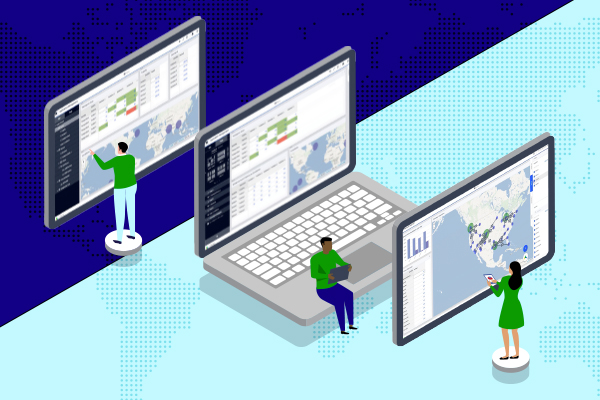This is a followup to our S&OE webinar and a guest entry by Sander van Lokven, General Manager at Districon Solutions North America, an AIMMS implementation partner. Districon is a consulting company that brings the power of optimization and analytics closer to supply chain processes.
What is S&OE and what does it entail to develop a companion app with optimization capabilities?
As Gartner explains, “a good way to think about S&OE (Sales & Operations Execution) is to picture a middleman that receives, interprets and forwards information between the operational and strategic levels.” S&OE is all about how reality compares to the S&OP plan. Our recent webinar shared 3 must-haves for companies to improve their S&OE capability. In this blog, we will cover some commonly asked questions about S&OE and S&OE applications, based on what we heard from our webinar audience. Let’s dive in.
S&OP/IBP and S&OE
How does S&OE, with variability challenges, connect to the IBP / S&OP process?
S&OP determines the boundaries within which S&OE is allowed to act. “As a rule of thumb, anything that covers the near-term horizon, commonly 0 to 3 months, is S&OE. [S&OE] deals with all the issues stemming from actual demand and supply (source: Gartner).”
In other words, S&OE picks up where S&OP leaves off. While the scope of S&OP might be monthly or quarterly, S&OE’s can be weekly or even daily.
S&OE and Data/Integration
End-to-end visibility is crucial to take collaborative decisions in S&OE. To achieve this, integrating with live data is helpful, as well as getting detailed flow data on product availability, customer demand and KPIs.
“End-to-end visibility is crucial to take collaborative decisions in S&OE.” – Tweet this
How can you get data visibility?
During the webinar, we showcased an AIMMS-based application developed by our consultants at Districon. In this case, visibility data was obtained from the company’s ERP and data warehouse, and through a direct interface with their Logistics Service Provider (LSP).
How many data sources are typically connected to S&OP and S&OE apps?
S&OP apps are usually connected to data warehouses. S&OE needs more operational data and therefore these types of applications are more often connected to source systems like ERP, WMS, OMS, and others. Depending on the situation, data type, and data freshness, it can be a mix of it all.
What about connections between S&OE and S&OP apps themselves?
Our customers have used the following integrations in the past, but the opportunities are not limited to these alone. Some examples:
- They have used the same source data, while for S&OP they would aggregate data into monthly and product group buckets, for S&OE they would use the product and day/week level of data.
- They have used capacity levels set during the S&OP process and tools for boundaries on minimum or maximum flows determined for S&OE.
- They have interfaced S&OE allocation decisions with the S&OP data environment to update actual volume flows.
How can an AIMMS app connect to source systems, like an ERP?
Integrations are developed in a custom way. Possibilities include direct integrations (read/write), Excel or other flat file uploads, an API, direct file transfer or through a transfer database.
Have you encountered issues with SAP integrations?
Not really. At Districon, we work very closely with IT departments to ensure their policies, data availability, quality and security, as well as interfacing preferences are carefully considered.
To develop a custom model for S&OE, how do you gather the raw data and what does the architecture look like?
We start developing the model based on extracts of system tables and separate files. In parallel, we set up the architecture for the data model and interfacing. During the project, we merge these two project streams into an application. As described above, there are multiple ways to integrate with data sources. This has a direct impact on the solution’s architecture.
In the case discussed during the webinar, we worked with an SQL database which is fed with event-based triggers that push data to the solution from the customer’s ERP. The AIMMS application is hosted on AIMMS PRO, which enables cloud-based deployment.
Typically, a user starts the AIMMS application from the AIMMS PRO portal. This AIMMS application allows the user to execute designed tasks using a web user interface. The AIMMS application reads data from the SQL database, runs scenarios, mathematical models and other analytics algorithms on the AIMMS PRO cloud environment and writes user-approved outputs back to the SQL database. These outputs trigger a collection of processes in the customer’s ERP, which then result in advised actions and/or update actual shipments.
Functionality
Are the KPIs used in AIMMS apps customized, depending on the company?
Yes, every customer can define the KPIs that they want in the solution and how these are calculated. Typically they discuss these with an implementation partner like Districon. We offer potential best practices from other companies as well.
Can you model carbon emissions in the solution? By product or by each shipment?
In the use case shown during the webinar, emissions are modelled on a shipment level and the translated to the product level based on their relative contribution to that shipment.
What sort of mathematical models are typically used to optimize these situations?
For S&OE solutions, the problem is usually Mixed Integer Linear Programming (MIP or MILP). We also create non-linear models (for example, for blending) or heuristic and Machine learning approaches for other situations, like detailed scheduling or route optimization.
Do you need other code/tech outside of AIMMS for the UI (user interface)?
AIMMS Developer is used to develop the optimization model. AIMMS offers a WebUI which is rendered with AIMMS PRO: AIMMS’ publishing platform for bespoke optimization applications.
Can you send targeted communications, for instance to the sales department or similar customer notifications?
Yes, while the application demonstrated during the webinar did not have this built-in, we have developed applications which send messages to other departments, for example to get approval from quality engineers before accepting a production plan.

How can AI assist during the S&OE process?
There are many ways in which an AIMMS application can work together with AI. Check out this article if you are curious. Generally speaking, AI can help during S&OE in several ways. Some examples:
- AI can be used to assess which customers are most likely to accept a delay in product delivery (and which are less likely to).
- AI can help assess the impact of disturbances on demand and supply parameters in a more differentiated way. For instance, to evaluate which product, supplier and customer is impacted severely, moderately or mildly.
- AI can be used to assess expected shipment delays.
Are the outcomes of the model connected to production planning and scheduling?
The tool showed during the webinar is disconnected from the production plan. In the current state, this S&OE tool provides input to determine when certain products should be produced and in which quantity they should be available for shipments. We are now extending this S&OE app to account for planning complexity at factories and to include the production capacity and capabilities at these factories, as well as suppliers’. Generally speaking, the outcomes of the model used in S&OE could be used to feed a production planning and scheduling application.
Benefits
What kind of benefits do companies get by leveraging AIMMS-based applications for S&OE?
Here are some of the benefits:
- Visibility of shortages and issues, both in detail as well as for high level KPI’s
- Ability to create scenarios to investigate the robustness of your supply chain, as well as alternative ways to solve an issue at hand
- Ability to take the optimal decision, supported by advanced analytics. You can evaluate different scenarios and get insight into the impact they have on other products and customers.
Project scope/timing
What is the typical lead time to develop an S&OE application?
An initial solution can be developed in 6-8 weeks and then enhanced in an agile way.
What are the costs for this type of project?
This is always dependent on scope. However, license costs range between $75K and $150K for the AIMMS platform for up to 5 concurrent users. Development and onboarding provided by Districon ranges from $60K to $80K.
We hope these frequently asked questions are useful when determining how to develop a supporting application for S&OE. If you have any remaining questions, feel free to reach out. For more information on this and related topics, sign up for our Supply Chain Digest.






